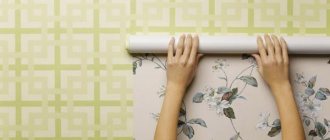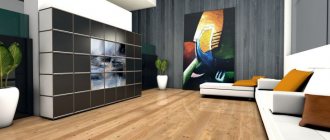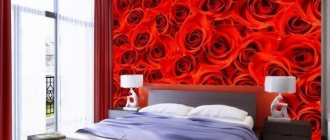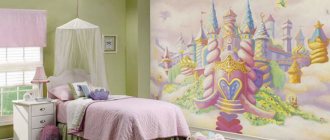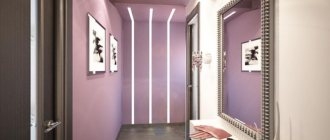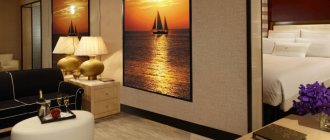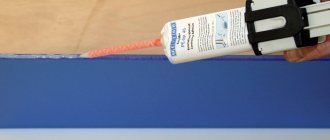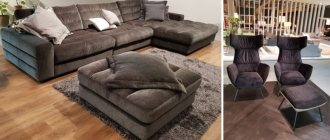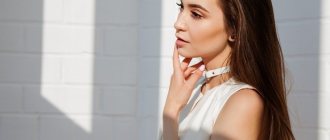Peculiarities
Technologies used in the production of wallpaper make it possible to create materials with a variety of textures and patterns. Vinyl-based wallpaper conveys with the finest clarity all the features of the design depicted on it (the roughness of burlap, the bend of a plant leaf, the structure of sea stone). Thanks to this, it becomes possible to create a unique design for any room, be it a mansion in an elite village or an apartment in a standard high-rise building.
Wallpaper consists of paper or non-woven fabric that makes up the base and polyvinyl chloride (which prevents moisture from entering the base layer). The vinyl layer does not dissolve in water, and when heated it becomes very plastic, which allows you to create a variety of patterns with different textures on the wallpaper.
Note! Wallpaper with a vinyl top layer and standard paper and non-woven wallpaper have a significant difference!
The main difference between them is the structure of the outer layer, strength, durability, and, accordingly, cost.
How such wallpapers are made
As you can already understand from the name, these wallpapers have two main layers - on a non-woven base there is a polyvinyl chloride coating (or, more simply, a vinyl coating). The technology used to produce such embossed vinyl wallpaper is not too complicated.
- A layer of specially prepared polyvinyl chloride is applied to the non-woven base.
- The web moves along the conveyor and enters a chamber with high temperature. There the material is heated until it becomes sufficiently plastic.
- The surface of the heated two-layer material is compressed using textured rollers of several different types.
- Cooling occurs. Wallpaper is ready for use.
Interesting embossing and design on the wallpaper
Of course, this is a very simplified manufacturing principle that does not take into account the application of color and image, but the main thing that can be understood from this production technology is that vinyl wallpaper, made by hot stamping and based on a non-woven base, is acquired during the manufacturing process properties of two materials at once. And this is precisely what makes them so popular in the first place.
Advantages and disadvantages
Wallpaper with a vinyl top layer has its pros and cons.
The main advantage of vinyl wallpaper is, as mentioned earlier, water resistance, which allows them to be used for finishing rooms with high humidity, for example, a kitchen or bathroom. In addition, such wallpaper can be cleaned with a damp sponge and detergents.
The vinyl layer protects the base from fading under the influence of sunlight, which has a beneficial effect on the richness and brightness of the design, which cannot be said about paper counterparts, allowing you to preserve the original appearance for a long time.
The advantages of this vinyl finish also include a wide range and ease of gluing.
The disadvantages of vinyl wallpaper include its airtightness. However, if the room in which you plan to use this type of wallpaper is of sufficient size and has good ventilation, then there is no reason for concern.
Advice! For small rooms, it is better to choose wallpaper with greater breathability and, unlike vinyl, which has a porous structure.
Many consumers, when choosing wallpaper for their apartment, bypass vinyl copies, believing that vinyl, being a chemical material, emits harmful fumes that have an adverse effect on human health. This opinion, to some extent, is fair, but applies only to cheap analogues manufactured without a license by Chinese manufacturers.
Advice! When buying wallpaper for home renovation, you should not save money and give preference to more expensive, high-quality products that have a quality certificate.
Varieties
Depending on the purpose and production method, vinyl wallpapers have the following types:
- washable;
- for painting;
- smooth vinyl;
- foamed vinyl;
- hot stamping (silk-screen printing, compact vinyl, inhibition, heavy vinyl).
A special feature of washable wallpaper is the possibility of using wet cleaning. This type of vinyl can be freely used for kitchen or bathroom walls, without fear that the wallpaper will peel off. When purchasing washable vinyl wallpaper, you should carefully study the product labeling, which indicates what type of cleaning is applicable to a specific type of finishing material. Washable wallpaper is divided into moisture-resistant (wet cleaning without the use of detergents), washable (can be washed with a damp soft sponge), super-washable (cleaning with a stiff brush).
Plain wallpaper for walls used for painting, as a rule, has a non-woven base and a textured top vinyl layer that can withstand up to 15 repaintings. Delicate shades of pastel colors or white allow you to choose any palette that harmonizes with the design of the room.
Smooth vinyl is the most common type. They have a smooth, dense surface that can withstand wet frills. Smooth wallpaper is widely used for kitchen decoration, allowing home owners to easily remove greasy stains or other contaminants from their surface. Despite the simplicity of the design, they have an attractive design and can be matte or glossy, and some even have a pearlescent sheen, giving the room a unique look.
Another common type, but already having a textured surface, is foam wallpaper. They are quite strong and durable, but do not tolerate moisture at all (especially paper-based foam). This is the most breathable wallpaper among other types, so you can safely decorate children's rooms and bedrooms with it.
Hot stamping wallpaper comes in several varieties. The texture of compact vinyl imitates many natural materials (stone, textile, bamboo), and the material itself is unpretentious and durable, and can withstand any mechanical stress. Compact vinyl is often called heavy vinyl due to its high strength and impressive weight. Like foamed specimens, heavy vinyl perfectly smooths out all surface imperfections.
Wallpaper covering that imitates one of the most expensive textile materials - silk-screen printing. Wallpaper with this embossing has an attractive glossy shine and is a favorite finishing material in the homes of sophisticated buyers. Despite the luxurious, rich appearance, the wallpaper is in a reasonable price category, which allows it to be purchased by different segments of the population.
Inhibited vinyl is not a type of vinyl sheet, but a type of production. The inhibited material is the same compact vinyl, only with an additional applied chemical layer that imparts special performance characteristics. The price of this category is the highest in relation to other types.
Gluing technology
Scheme of the sequence of work on wallpapering the ceiling.
Hot-stamped wallpaper should be glued using the same technology that underlies gluing with conventional wallpaper. However, there are still certain features. So, it is not permissible to glue hot-stamped wallpaper by stretching it in width, otherwise you can get gaps between the joints after drying, since the material can stretch and shrink.
Before you start work, you should double-check that all purchased rolls belong to the same batch. Neither the color nor the design should be different.
In order to correctly determine the length of the strip, you need to add about 7 cm to the height of the room. The canvases are cut so that the pattern of adjacent sheets coincides, forming a single element of the pattern. Rolls should be unrolled in one direction, which is indicated on the label, and cutting should be done using 2 or 3 rolls at a time.
Wallpaper can be glued to almost any surface, including drywall, permanently old paint or plaster. If the walls are covered with old wallpaper, they should be thoroughly cleaned. It is recommended to treat cracks and holes using putty and plaster.
Before gluing wallpaper, you should prepare the adhesive mixture. It is recommended to purchase special glue designed for non-woven coatings. In the process of preparing the glue, you should follow the instructions.
The glue is applied directly to the base of the wall using a paint roller. The canvases should be coated so that there are not even small gaps left on them. You also have to make sure that the glue is not applied in too thick a layer. Afterwards, the canvas needs to be folded in half, which will help prevent drying out. In this state, the canvas should be left for about 10 minutes until it “swells.”
Afterwards, the panel must be straightened and glued to the surface. At this stage, it is important to ensure that the canvas does not stretch. Each canvas should be pressed down with a stiff brush or clean rag.
In order to hide the seams, the first strip should be strengthened, starting from the window. The start of work must be accompanied by marking a vertical line using a plumb line or level. The first strip should be glued along the vertical markings. It is recommended to leave a small amount of wallpaper at the bottom and top, which will allow you to even out any unevenness. The next strip should be glued butt to the previous one. A soft brush or rubber-based roller will allow you to smooth the canvas; movements should be directed towards the edges from the middle.
In order to better glue the edges, it is recommended to apply the adhesive mixture in the places where they are connected, then the excess glue must be carefully removed. Until the wallpaper is completely dry, you should maintain a constant temperature in the room, avoiding drafts. If you are gluing wallpaper on problematic walls, you need to place a thin strip of paper under the joints, which will prevent the edges from lagging behind the base of the walls.
Choosing wallpaper is a very important decision in any renovation process. Some people like to glue “forever” and choose materials that can maintain a spectacular appearance for 8-10 years, while others, on the contrary, prefer to change the appearance of the walls every 2-3 years.
The necessary price-quality ratio, interesting color and all kinds of patterns, moisture resistance, the ability to survive scratches, shocks and children's drawings - the ideal wallpaper should meet all these qualities. For this reason, representatives of various segments of the population are increasingly choosing vinyl wallpaper for their walls.
This type of wallpaper has a beautiful, rich pattern.
Marking
When purchasing wallpaper finishing material, it is important to pay attention to the markings. The signs indicated on the roll indicate the characteristics of the product and its performance properties.
Designations are divided into several groups and indicate:
- degree of moisture resistance (moisture resistant, washable, super washable);
- degree of light fastness (sufficient, satisfactory, good, very good, maximum);
- method of processing with glue (wallpaper only, wall only);
- method of removal (dry or soaked);
- degree of impact resistance;
- beginning of the pattern:
- without a beginning - no need to follow the pattern;
- direct start - identical patterns are glued next to each other;
- the beginning is offset - identical patterns are glued offset;
- reverse – the adjacent strip of fabric is glued in reverse.
Interior use
The varied palette and texture of vinyl wallpaper make it possible to easily create an interior that satisfies the needs of the most sophisticated connoisseurs of beauty. It is not for nothing that this type of finishing is highly valued among designers all over the world. Non-woven or paper-based wallpaper, the palette of which exceeds several dozen varieties, will be an excellent finishing option not only in an apartment, but also in a cafe or restaurant.
Vinyl wallpaper stickers have become very popular lately. An ornament of various designs and patterns is pasted onto the surface of plain wallpaper in a certain place, creating a unique effect. You can choose large stickers for the living room or kitchen, and add several smaller stickers to them and place them on the surface of the furniture. For the bedroom it is better to choose delicate stickers in pastel colors, and for the nursery - bright stickers depicting fairy-tale characters or animals. For the kitchen walls, it is recommended to select stickers with images of fruits and vegetables, and for the bathroom – marine themed stickers.
Where to glue
Where vinyl wallpaper is appropriate
Vinyl wallpaper can be hung anywhere. However, if you take into account their characteristics, you can indicate specific places where they will be indispensable. This material is perfect for the hallway. Usually repairs are made here taking into account the fact that dirt from the street will certainly get on the walls and floor.
Vinyl wallpaper is very resistant to moisture, in addition, it can be washed. One wet cleaning and there will be no dirt. Therefore, when once again considering the renovation of a corridor or hallway, you should definitely consider vinyl wallpaper as a finishing option.
Such materials are also suitable for rooms where there is a high risk of high humidity. They can be used in public places where there is a risk of contamination. However, wallpapering is also done in ordinary apartments. After all, vinyl wallpaper looks great.
Vinyl wallpapers are divided into two more types:
- wallpaper without embossing;
- wallpaper with hot stamping.
Some people ask how to glue embossed vinyl wallpaper and whether this process is different from gluing other vinyl materials. At its core, the process is not very different, although some subtleties in the work will have to be taken into account.
Preparation for gluing
Preparing the walls
The first step when preparing walls for gluing is to remove the old coating. The previous wallpaper layer may become deformed under the influence of glue and spoil the appearance of the new finish. In addition, mold and mildew may form under the old layer.
Walls painted with paint (oil, water-based, enamel) should also be cleaned.
The second stage of preparation is leveling the surface and eliminating all defects. To remove chips and cracks, putty is used, after which the wall is treated with a small layer of primer. The wallpapering process should begin after the surface has completely dried.
Coating preparation
Before the actual gluing process, you should prepare the wallpaper. The width of the vinyl wallpaper is sufficient to avoid unnecessary joints. The roll is cut into strips of equal length with an allowance of 10 cm and stacked in a stack of no more than 10 pieces. face down.
Applying glue
For flawless gluing of paper-based wallpaper, the glue should be applied directly to the finishing material and then left to swell for the time indicated on the roll. The layer of glue should be uniform over the entire surface of the cuts, as well as the impregnation time. The adhesive should be selected based on the recommendations indicated on the label.
